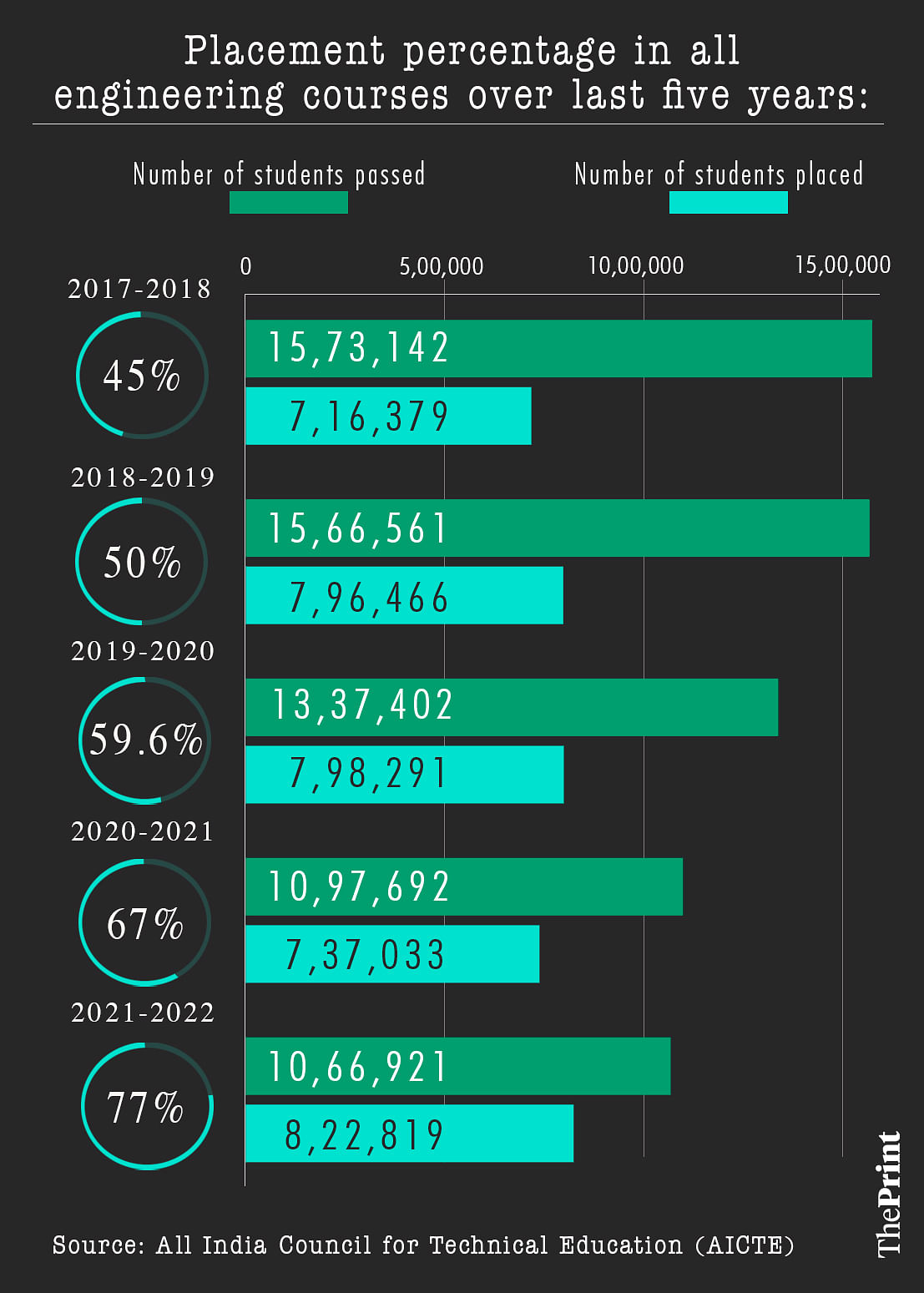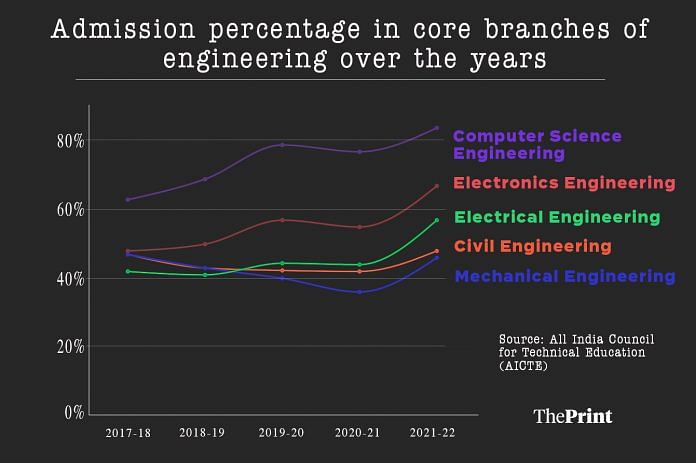New Delhi: After a dip in previous years, the demand for engineering courses, especially core branches like computer science, electronics and mechanical, is again picking up, data from the All India Council for Technical Education (AICTE), accessed by ThePrint, has shown. Placements for engineering have also gone up in the corresponding period.
This is why the council decided to lift the moratorium on new engineering colleges earlier this month, which means more engineering colleges will be allowed to come up from the academic year 2023-24 onwards.
Computer science and electronics engineering continue to be the top choices among college students while percentage in mechanical and civil, though up in recent years, continue to be comparatively low.
The overall admission percentage in all engineering courses has also gone up in the last five years. In 2017-18, 18,95,452 of the 35,50,947 seats were filled, which took the admission percentage to 53 per cent. In 2021-22, of the 29,76,777 seats on offer, 17,59,885 were filled up, taking the admission percentage to 59 per cent.
A senior AICTE official, who did not wish to be named, told ThePrint that the council had conducted an internal survey last year and found that the demand for core branches of engineering was going up, which is why it was felt that the ban on new engineering courses should be lifted.
According to the internal report, accessed by ThePrint, admission percentage in most core engineering branches hit a five-year high in 2021-22.
According to the AICTE data, the admission percentage in computer science was 63 per cent in 2017-18, which went up to 69 per cent in 2018-19 and 79 per cent in 2019-20. The percentage dipped to 77 in 2020-21 and then jumped again to 84 in 2021-22.
Similarly, in mechanical engineering, the admission percentage was 47 in 2017-18 that went down to 43 in 2018-19. It further went down to 40 and 36 per cent in 2019-20 and 2020-21, respectively. The percentage has now bounced back up to 45.9 in 2021-22.
For electronics engineering, the admission percentage was 47.6 per cent in 2017-18, 50 per cent in 2018-19 and then shot up again to 56.6 per cent in 2019-20, before going down to 55.3 in 2020-21. At 67.3, the admission percentage was at a five-year high in 2021-22.
The data shows a similar trend of admission percentage declining and then picking up in other branches like civil and electrical engineering as well.
Officials said the increase in admission percentage was because the seat count went low due to the moratorium and it was seen that more students are interested in seeking admission to core branches.
In 2020, AICTE had put a ban on opening of new engineering colleges as it was seen that the demand for engineering was low and seats were lying vacant. That, however, is not the case anymore, as was seen by AICTE in its internal study last year.
Rajive Kumar, member secretary AICTE, told ThePrint, “The demand was not low earlier, but the supply was more. We needed to review the demand, supply issue and, hence, the moratorium was put in place.”
The council, however, has also urged institutions to open courses in emerging areas like Artificial Intelligence and machine learning, along with the core courses.
Also Read: What explains the ‘33 student suicides at IITS since 2018’ — academic stress, mental health issues?
Placement numbers high too
The AICTE report shows that 2021-22 was also when the placement percentage of students was the highest in last five years, from 2017-18 onwards.

In 2017-18, 7,16,370 of the 15,73,142 students who passed that year were placed, taking the placement percentage to 45 per cent. In 2021-22, 8,22,819 of the 10,66,921 who passed out were placed — significantly improving the placement percentage to 77 per cent.
According to the data, 77 per cent students in engineering courses were placed in 2021-22 against 67 per cent in 2020-21. The placement percentage in 2019-20 was 59.6 per cent, slightly more than 2018-19 when the percentage was 50. At 45 per cent, placement was lowest in 2017-18.
A senior AICTE official who did not wish to be named told ThePrint that the placement percentage going up was also a reason that the committee examining the moratorium decided to lift it.
“There was a perception being created among the stakeholders that engineering education was no longer relevant or needed, and that needed to be changed. When we can see that there is a demand for engineering courses, especially in core areas, then why not create the avenues,” he said.
Sources in the council also said that the opening up of core branches was necessary because to create ‘Atmanirbhar Bharat’, the country needs engineers who can work in core areas like civil, mechanical, electronics and others.
(Edited by Richa Mishra)
Also Read: IIT-Delhi among top 50 world institutions for engineering in QS Rankings, DU has most ranked entries






